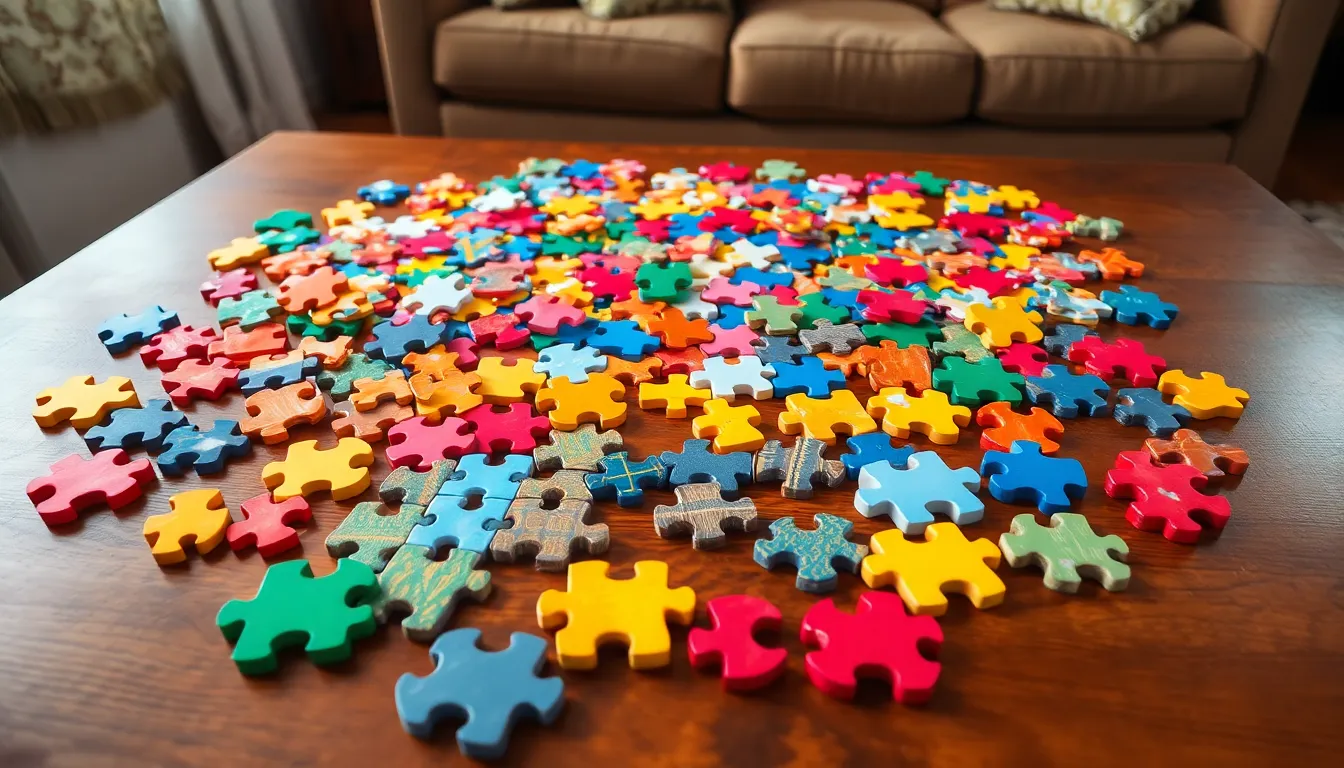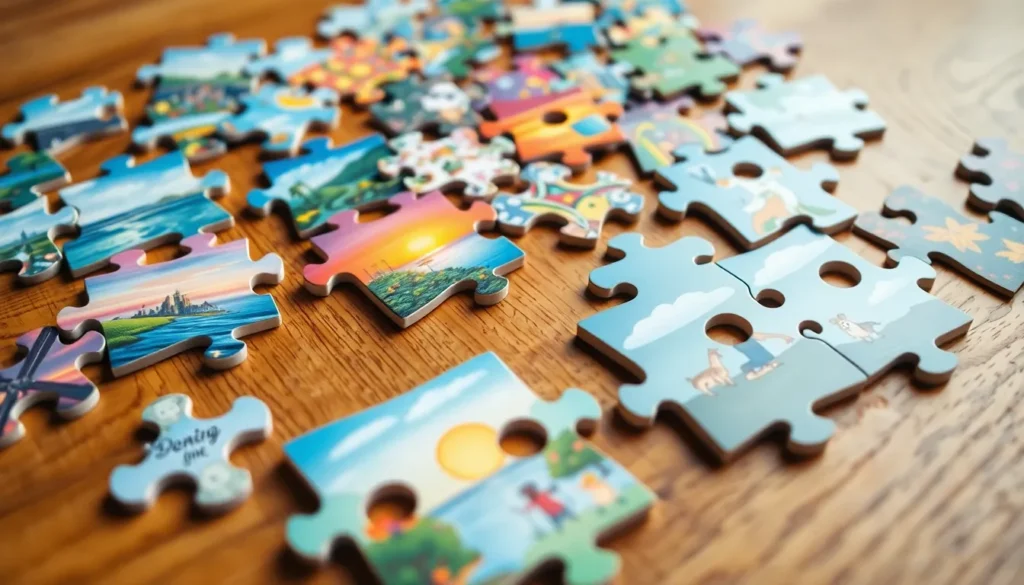Jigsaw puzzle pieces might seem like simple cardboard cutouts, but they hold the power to unlock hours of entertainment and brain-boosting fun. Imagine diving into a colorful world where each piece is a tiny adventure waiting to connect. Whether it’s a serene landscape or a whimsical cartoon, these little shapes challenge minds and bring families together, one piece at a time.
Jigsaw Puzzle Piece
Jigsaw puzzle pieces come in various shapes and sizes, designed to fit together seamlessly. Each piece features a unique interlocking design that enables it to connect with others, forming a complete image. Typically made from cardboard or wood, these pieces often possess vibrant colors and detailed graphics, enhancing the overall aesthetic of the puzzle.
Manufacturers create jigsaw puzzles with different piece counts, ranging from a few dozen to several thousand pieces. This diversity caters to a wide range of skill levels, making puzzles accessible to children and adults alike. Finding the right puzzle can provide a satisfying challenge, whether someone prefers a simple illustration or an intricate design.
Notably, manufacturers use distinct shapes for each puzzle piece, which can vary between brands. Some pieces feature knobs and holes, while others may have smooth edges. These variations not only add complexity to the puzzle-making experience but also increase the visual interest of the completed product.
Puzzle pieces often come packaged with a reference image, guiding solvers in assembling the final picture. This visual aid helps individuals identify similar colors and patterns, making it easier to locate matching pieces. Using this strategy fosters better organization and enhances the total enjoyment of the activity.
Aside from being fun, jigsaw puzzles promote cognitive skills, including problem-solving and memory retention. Engaging in puzzle assembly challenges the brain, encouraging critical thinking and spatial awareness. Thus, it’s no surprise that families often gather around the table to piece together their favorite designs.
Types of Jigsaw Puzzle Pieces

Jigsaw puzzle pieces come in various designs, each enhancing the overall building experience. Different types cater to varying preferences and skills, ensuring that everyone can find a suitable challenge.
Standard Pieces
Standard jigsaw puzzle pieces feature a traditional interlocking design common in many puzzles. Each piece typically has a square or rectangular shape with knobs and holes that allow for easy assembly. Most puzzles utilize approximately 500 to 1,000 pieces, making them ideal for both beginners and seasoned puzzlers. The consistency in shape provides a familiar challenge, allowing puzzlers to focus on completing the image rather than navigating complex piece designs. Additionally, the sturdy cardboard construction ensures durability, enabling users to enjoy the puzzle multiple times without wear.
Unique Shapes
Unique shapes offer a refreshing twist on the traditional jigsaw format. Some puzzles incorporate whimsical or themed pieces that deviate from standard forms. For instance, animal-shaped puzzles might feature pieces shaped like the animals themselves, adding an element of fun and creativity. Edge pieces can also take on different configurations or curves, presenting a different challenge. These unique designs typically come in smaller quantities, around 100 to 300 pieces, bringing an alternative experience for those seeking variety. Engaging with these innovative shapes encourages imaginative thinking and broadens the appeal of jigsaw puzzles.
Material Used in Jigsaw Puzzle Pieces
Jigsaw puzzle pieces can be crafted from various materials, each offering unique characteristics and advantages.
Cardboard vs. Wooden Pieces
Cardboard pieces dominate the jigsaw puzzle market due to their affordability and lightweight design. Often manufactured using recycled materials, these pieces maintain durability and ease of use. Wooden pieces, on the other hand, provide a premium feel and increased sturdiness. Highly sought after for their tactile quality, wooden puzzles often feature intricate designs. Many puzzle enthusiasts prefer wooden options for their longevity and aesthetic appeal.
Eco-Friendly Options
Eco-friendly puzzle options gain popularity as sustainability becomes a priority for many consumers. Manufacturers now create puzzles using sustainable materials, like recycled cardboard and biodegradable inks. Bamboo and other renewable resources also serve as alternatives for eco-conscious buyers. These options reduce environmental impact while maintaining quality and visual appeal. Many jigsaw puzzle makers prioritize manufacturing processes that align with these values, ensuring puzzles are both enjoyable and responsible.
The Importance of Jigsaw Puzzle Piece Fit
The fit of jigsaw puzzle pieces significantly impacts the overall solving experience. Seamless connections between pieces enhance the satisfaction derived from piecing together the image. Tight-fitting pieces prevent misalignment, allowing for a smoother assembly process.
Perfectly fitting pieces contribute to cognitive engagement. They encourage problem-solving as individuals assess how each piece interlocks with others, fostering critical thinking. As he or she navigates the shapes and colors, memory retention improves through repetitive patterns and arrangements.
Different puzzle types cater to varying skill levels, reflecting their design’s importance. Standard interlocking pieces widely used in traditional puzzles typically offer between 500 and 1,000 pieces. These pieces provide a rewarding challenge, while unique-shaped pieces, like animal designs, offer an alternative for those seeking creative engagement with 100 to 300 pieces.
Material choice also influences how well pieces fit. Cardboard pieces remain popular for their affordability, while wooden pieces deliver a premium tactile experience. Enthusiasts often appreciate the sturdiness of wooden designs, which enhance the overall puzzle encounter.
Manufacturers prioritize sustainability, leading to eco-friendly puzzle options. Biodegradable inks and recycled materials allow creators to produce high-quality puzzles without harming the environment. This shift demonstrates a commitment to quality and visual appeal while ensuring that users enjoy their puzzle experience responsibly.
Focusing on fit and design creates a fulfilling activity for family bonding. Gathering around the table eases stress and enhances social interactions as pieces come together to form a complete picture. Therefore, understanding the significance of jigsaw puzzle piece fit enriches the overall enjoyment and cognitive benefits associated with this timeless pastime.
Conclusion
Jigsaw puzzles offer more than just entertainment; they create lasting memories and foster connections among family and friends. The variety of pieces and materials available ensures that there’s a perfect puzzle for everyone, whether they’re beginners or seasoned enthusiasts. As more people seek sustainable options, the puzzle industry adapts to meet these needs while maintaining quality and engagement.
The joy of fitting pieces together is a timeless experience that enhances cognitive skills and encourages creativity. Embracing this simple yet profound pastime can lead to countless hours of enjoyment and personal growth, making jigsaw puzzles a cherished activity for generations to come.

